
This is a response to this post by lumpley (AKA Vincent). You should read at least the first few examples of it before reading this.
It's important, when analyzing something, to simplify it to its most important elements, where that simplification doesn't discard anything important. When just thinking about something, you should be careful not to simplify too soon; work out the patterns, then simplify. I think lumpley has simplified some things wrong, so I'm going to start over with the un-simplified case and work down to something simpler.

Starting from the die and proceeding clockwise, we have: mechanics tools (die), quantifiable game state (figures), props (crown), players (smiley faces), munchies (Dew), the fiction (cloud), the rules (book), and, overseeing it all, the gamemaster (frowny wizard).
In more detail: mechanics tools are used for randomization and resolving, e.g. dice, coin flips, possibly calculators, measuring instruments at athletic events. Quantifiable game state is things like hit points, locations of Monopoly tokens, cards in your hand. Props are game-related elements that are in no way game-mechanical, like painted figures used for atmosphere, or an audio soundtrack played in the background by a gamemaster. The fiction is some set of things that are true about the fictional world in which the game is taking place (Wittgenstein: "the world is everything that is the case"). The rest are self-explanatory. (This is not to say that all games need a gamemaster. I am just avoiding oversimplifying too soon for games that do have one.)
Now, when we talk about interactions that occur over the course of a game, any game, we can understand that those interactions are governed by the rules. If Bob gets pissed off and punches out Gene, and the game at hand doesn't involve players actually resorting to real-life fisticuffs, then their activity is outside the game and shouldn't be diagrammed on the chart. Any activity that takes place in the game is going to be governed by the rules.
Let's take a sample rule for a monopoly-like game. "Roll a die and advance your token that many squares on the board."
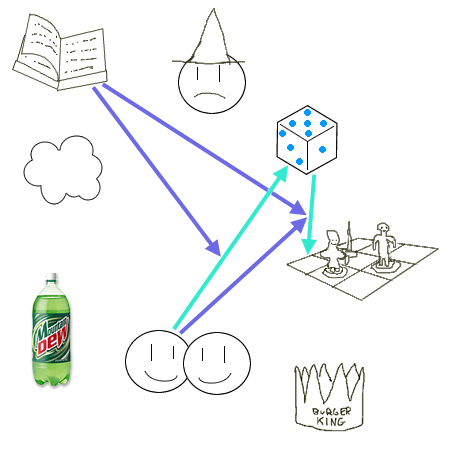
Each teal arrow is an individual interaction. Each blue arrow is a "moderating" effect on an interaction. (It's hard to draw a three-way interaction with a single arrow unless they happen to be in a line). So, first, the player rolls the die (as moderated by the rules); then, the result on the die indicates how to update the game state (move the token), which is performed by the player, as moderated by the rules.
Now, a few things are clear. First, the player doesn't have to be the one to move the token. Another player might move it instead if it happens to be hard to reach for the first. The player doesn't actually have any choice; so the fact that it's the player picking up and moving the token is irrelevant. Second, as described earlier, every interaction is going to be moderated by the rules (at least weakly), so we're always going to have a moderated-by arrow from the rules; so there's no reason to draw them. That leaves us with this simplified drawing:
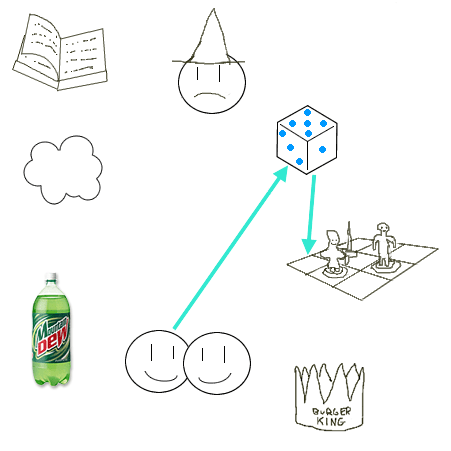
Note that this representation of an interaction is about as conceptually simple as lumpley's--it only has two arrows--but it has more information, because we haven't oversimplified the participating elements.
Now, you could argue that I should go ahead and simplify at least some of the other elements away--that many of these icons are obviously unnecessary to the game, e.g. the props and the munchies. Just to confuse matters, here's a different kind of game, with rules-moderation arrows omitted.
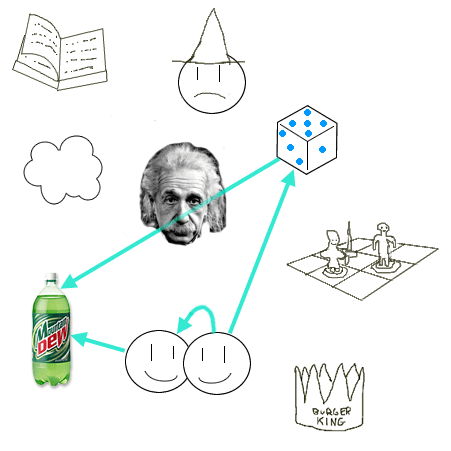
"If the player bounces the quarter into the cup, then the player can require any other player to drink the cup." Here I've used lumpley's notation of an arrow going through a middle item to indicate moderation: the mechanics of whether the quarter (represented by the icon here) goes into the cup or not are determined not by a random number generator, but by the laws of physics. Again, I think it is overkill to indicate moderation. Of course, this is a game best played in moderation.
Now, let's imagine a game that's GMed, and has rule #2 of lumpley's: "2. Subtract the roll on the damage die from your character's hit points." I'll omit moderation-by-the-rules arrows, of course.
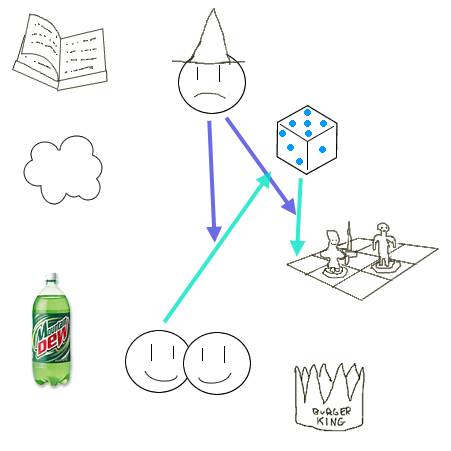
Ok, so the player rolls the die (arrow from player to die). Of course, the player does this under the watchful eye and guidance of the GM, so we need a moderation arrow there. Then, the player updates their own hit points on their character sheet, again under the watchful eye of the GM. Guess what? Everything's under the watchful eye of the GM, so let's screw those GM moderation arrows.

To be honest, I don't understand lumpley's arrows, so maybe lumpley won't understand mine. Lumpley uses an arrow from the die ("tokens, things, props, representations") to the faces ("the interactions of the player themselves") to indicate the rolling of the die. Why? No clue. Maybe it should be three arrows: 1. the player rolls the die (player->die). 2. the player reads the value of the die. (die->player). 3. the player change the value of the hit points. (player->die)
Of course, as I've pointed out, the reading of the value of the die and updating of the hit point value by the player involves the player in an entirely uninteresting way, so I don't think step #2 is interesting. But my way of interpreting 2 & 3 combined is to draw from (on my chart) die to figures; since lumpley combines mechanics tools and quantifiable state into a single element, he'd have to draw an arrow from the die to the die, which perhaps explains why he did it the way he did. Of course, if you want to show that this die-to-die interaction is moderated by the players by making it go through the players, you'll have a curving line go from the die to the players and then back to the die; which is basically the same as the three lines I proposed above.
Now, note that if the GM follows the same rule to handle an NPC, on my chart I'd have to change the source of the first arrow. I don't need to update the second arrow. I'm not distinguishing between state represented physically on a character sheet and state kept entirely in the GM's head.
Ok, here's a more complex lumpley rule: "5. If your character's opponent tries to disarm your character, make a Hold Weapon check. If you fail, your character is disarmed, and you thus suffer the unarmed penalty until you retrieve your weapon."
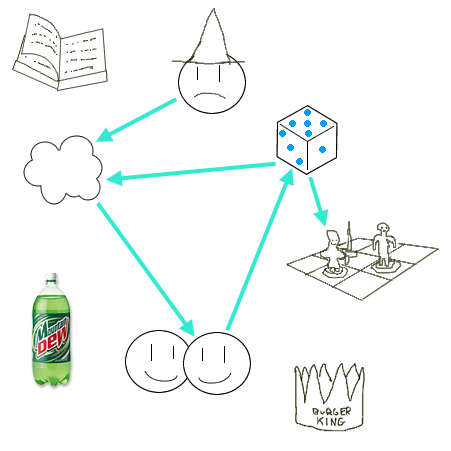
Again, imagining a GM'd game, we have the following sequence. The GM (pointy hat) decides that the the opponent tries to disarm (fictional cloud). This state of the fiction requires that the player make a Hold Weapon check (die roll). [Note that, in truth, the hold weapon check involves various quantifiable state--character level or strength or whatever, so perhaps the arrow here should be more subtle.] On a failure, we imagine the character is disarmed in whatever manner (non-quantifiable fictional cloud) and also in the quantifiable state (figures).
Note that the GM-causing-the-fiction is something I added explicitly to clarify. Note that it's misleading to draw an arrow from the fiction to the player; really it should be that the fiction moderates the need for the Hold Weapon check. But hang on for a moment; really, the GM chose to put the NPC in the "state" of "trying to disarm this player character"; since there are some limited numbers of such states that the rulebook has explicit resolution rules for, maybe that should be considered quantifiable state, too?
This is important because lumpley notes in the comments that a distinguishing characteristic of the RPG is the fact that arrows emerge from the fictional cloud at all; no matter how cleverly you describe events transpiring in Settlers of Catan, none of the other players are going to let you build an extra road segment.
So maybe the arrow from the fictional cloud should point to the quantifiable state: sometimes the fictional cloud implies certain discretely quantifiable states-of-the-world for which there are explicit game-mechanical rules. That state then mandates the Hold Weapon check. (I still don't like the idea of "mandates" being given by an arrow.)
If you go look at lumpley's, I'm not sure what's going on there. The long arrow from the fictional cloud to game-tokens/state is "make a Hold Weapon check"? Basically, I think I'm not sure on where lumpley's coming down with quantifiable vs. non-quantifiable state, so I'm trying to be explicit about this.
The other thing we can conclude is that, for this rule at least, we might as well have folded the GM in with the players into a single icon on the chart. The "Hold Weapon roll" rule is going to apply to any character--whether PC (rolled by player) or NPC (rolled by GM)--and whether they were attacked by an NPC (action chosen by GM) or PC (action chosen by player). However, in a classic game-mastered game, the players have limited director powers compared to the GM, so there may be other sorts of rules where this distinction is significant. (Or perhaps more in a meta-rules sense?)
Finally, I want to suggest that while it is true that RPGs make special use of the fictional cloud, this is not a trivial matter. On the one side, as suggested above, if there's a rule for it, it must be on some level quantifiable and belong to the quantifiable area. Looking at the flip side, it's argued that for a game like Settlers or Monopoly, the fictional happenings can never affect the game outcome; they are purely atmospheric. However, I carefully included a "props" element here that is purely atmospheric even for an RPG.
Lest you think that this simply applies to gamers wearing silly hats, consider that in some gaming groups, players are not rewarded game-mechanically for talking accurately or realistically as if they were their character (e.g. so as not to penalize members of the group who are poor actors). Similarly, in some groups, a character with fast-talking skill will succeed independent of that character's player's plausible fast-talking scenario (as long as the player at least tries); in which case any of those details are purely atmospheric.
Vincent could still conclude (fairly) that these elements are indeed atmospheric; they are part of the fun and style of the game, but they are not interesting from a standpoint of how the game works qua game. However, as you move away from strongly-mechanical games and you move into more freeform narrative games, removing any notion of quantifiable state, this gets fairly muddy. Perhaps this means quantifiable state starts to blur into fiction state. But if that blurring and slipperiness means it's hard to distinguishable quantifiable state from non-quantifiable fiction state, I definitely think it's wrong to try to clump quantifiable state with game-mechanical tools.
The eight elements also offer up some opportunities to think about other things. (A friend points out an important scenario: an arrow from Dew to rules to GM to fiction: somebody spills soda on the GM's rulebooks, and the GM has the character attacked and killed by magical blue lighting, no saving throw.)
In a computer game, the computer takes over the responsibilty for managing most (all?) interactions. However, those interactions still go occur, simply moderated by the program. There are still quantifiable states, mechanics for updating them (possibly randomly). There may be fiction (human-authored, mostly), and this fiction is updated and revealed as a consequence of the mechanics. (There is, of course, generally never any feedback from this non-quantifiable fictional state back into the game; it's text and cut scenes that are output-only.)
You should probably comment back on the original thread.